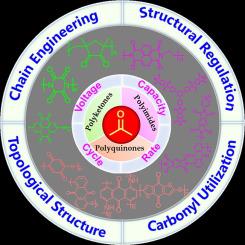Materials Today ( IF 21.1 ) Pub Date : 2021-09-06 , DOI: 10.1016/j.mattod.2021.08.006 Qing Zhang 1 , Xun Cui 1, 2 , Shumeng Hao 2 , Qiang Zhang 3 , Zaiping Guo 4 , Huiqiao Li 5 , Zhiqun Lin 2 , Yingkui Yang 1

|
The ever-growing demand for energy and the excessive consumption of fossil fuels, accompanied with the rising environmental issues, has brought about an urgent requirement to seek high efficiency and green energy techniques. Lithium-ion batteries (LIBs) employing inorganic electrode materials have dominated such markets over the past decades. However, inorganic materials are being faced with their inherent limitations in specific capacities, mineral resources, and mechanical fragileness as well as eco-sustainability and cost-efficiency. In the last years, carbonyl polymers as electrode alternatives for LIBs have attracted considerable attention due to their high capacities, fast redox kinetics, chain designability, abundant resources, processing compatibility, and mechanical flexibility. Herein, a timely and comprehensive overview of the state-of-the-art knowledge is thoroughly summarized. Particular attention lies on the work principles, chain engineering strategies, carbonyl utilization, and electrochemical activities of carbonyl polymers. The structure-to-performance relationships concerning microstructures, topologies, and composites with nanocarbons are also scrutinized. Current challenges and future perspectives are finally proposed. This Review aims to provide an in-depth insight into the emerging topic of developing redox polymers for the next generation of high-performance batteries, in response to the imperative for the sustainable development of economy and society.
中文翻译:

用于可持续锂离子电池的羰基聚合物链工程
能源需求的不断增长和化石燃料的过度消耗,伴随着日益严重的环境问题,迫切需要寻求高效、绿色的能源技术。在过去的几十年中,采用无机电极材料的锂离子电池 (LIB) 一直主导着此类市场。然而,无机材料在比容量、矿产资源、机械脆弱性以及生态可持续性和成本效益方面正面临着其固有的局限性。在过去几年中,羰基聚合物作为 LIB 的电极替代品,由于其高容量、快速氧化还原动力学、链可设计性、丰富的资源、加工兼容性和机械灵活性而引起了相当大的关注。在此处,对最新知识进行了及时和全面的概述。特别关注羰基聚合物的工作原理、链工程策略、羰基利用和电化学活性。还仔细研究了有关微观结构、拓扑结构和纳米碳复合材料的结构与性能关系。最后提出了当前的挑战和未来的展望。本综述旨在深入了解为下一代高性能电池开发氧化还原聚合物的新兴主题,以响应经济和社会可持续发展的迫切需要。和羰基聚合物的电化学活性。还仔细研究了有关微观结构、拓扑结构和纳米碳复合材料的结构与性能关系。最后提出了当前的挑战和未来的展望。本综述旨在深入了解为下一代高性能电池开发氧化还原聚合物的新兴主题,以响应经济和社会可持续发展的迫切需要。和羰基聚合物的电化学活性。还仔细研究了有关微观结构、拓扑结构和纳米碳复合材料的结构与性能关系。最后提出了当前的挑战和未来的展望。本综述旨在深入了解为下一代高性能电池开发氧化还原聚合物的新兴主题,以响应经济和社会可持续发展的迫切需要。











































 京公网安备 11010802027423号
京公网安备 11010802027423号